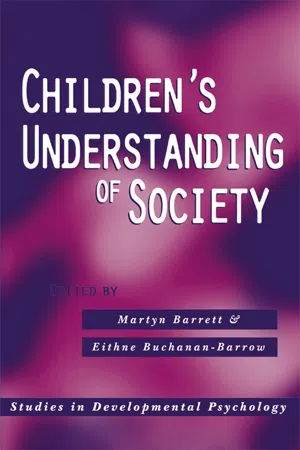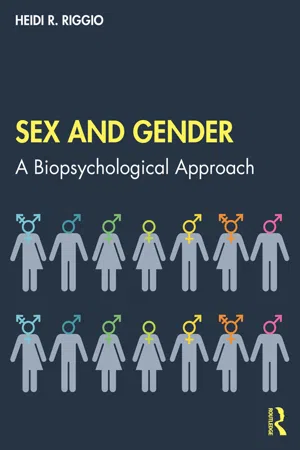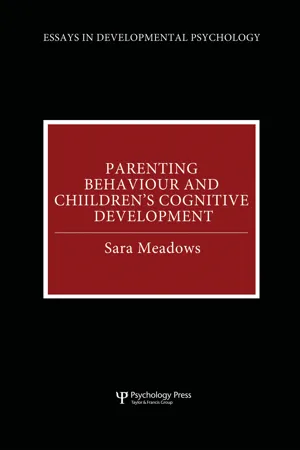Psychology
Cognitive Explanations of Gender Development
Cognitive explanations of gender development focus on how children's understanding of gender roles and identities evolves as they grow. This perspective emphasizes the role of cognitive processes, such as categorization and schema formation, in shaping children's perceptions of gender. It suggests that children actively construct their understanding of gender through observation, internalization of societal norms, and self-socialization.
Written by Perlego with AI-assistance
Related key terms
10 Key excerpts on "Cognitive Explanations of Gender Development"
- No longer available |Learn more
Gender
Psychological Perspectives, Seventh Edition
- Linda Brannon(Author)
- 2016(Publication Date)
- Routledge(Publisher)
In summary, social learning theory views the development of gender-related behaviors as part of the overall development of many behaviors that children learn through observation and modeling. This theory emphasizes the contribution of the social environment to learning and behavior. Social learning theory sees learning, which occurs through observation, as cognitive and separate from performance, which is behavioral. Whether a learned behavior is performed depends on the observed consequences of the behavior and the observers’ beliefs about the appropriateness of the behavior. Thus, children have many opportunities to observe gender-related behaviors from a wide variety of models, to develop beliefs about the consequences of those behaviors, and to exhibit gender-related behaviors as a result of their observation of these models.Cognitive Theories of Gender Development
Sandra Bem (1985) criticized social learning theory, arguing that the theory portrays children as too passive; she believed that children are more actively involved in developing gender identity than social learning theory hypothesized. Bem argued that children do not exhibit a gradual increase in gender-related behaviors, but rather form cognitive categories for gender and then acquire gender-related knowledge around these categories. In addition, research evidence suggests that children may develop stronger gender stereotypes than their parents convey, which implies that children organize information about gender actively. Thus, another way to look at gender development places an emphasis on cognition. These theories include cognitive developmental theory and gender schema theory.Cognitive Developmental Theory
The cognitive developmental theorist Lawrence Kohlberg (1966) described this theory by saying, “Our approach to the problems of sexual development starts directly with neither biology nor culture, but with cognition” (p. 82). Cognitive developmental theory views the acquisition of gender-related behaviors as part of children’s general cognitive development. This development occurs as children mature and interact with the environment, forming an increasingly complex and accurate understanding of their bodies and the world around them. - eBook - ePub
- Martyn Barrett, Eithne Buchanan-Barrow(Authors)
- 2004(Publication Date)
- Psychology Press(Publisher)
In sum, there is no doubt that the media present stereotyped, if occasionally heterogenous, representations of gender roles and there is no doubt that children are avid consumers of the media, especially television. However, this correlation does not confirm a unidirectional causal relationship in respect of children's own gender role development or their understanding of gender roles in society. Instead, consistent with the broad thrust of cognitive developmental theories (and some aspects of social cognitive theory), children turn out to be discerning viewers who attend selectively to the material available and interpret it in accord with their developing naїve social psychologies of gender and their personal (though gender-linked) preferences. They also, once again, filter the information through affective processes, and are quite ready to reject ideas and images if they are incompatible with their theories and values.CONCLUSIONS
Gender is given, grown, imposed, expected, regulated, learned, reflected upon, enacted, experienced, and shared. In this complex, multifaceted, and multidetermined minefield, children are actively engaged as thinkers and as emotional beings striving to determine who they are and how they relate to the social structure. Early attempts to explain gender role development tended to ignore or neglect the child's understanding. Cognitive developmental theories corrected this and inspired a large body of fruitful research, though these theories in turn have tended to neglect how children feel about gender. As in much cognitive developmental work, they tended to treat the child as a cognitive isolate or mini-scientist engaged in interesting epistemological quests with little reference to anyone else. Recent developments within cognitive developmental theory and at the points of intersection with social psychology have brought social processes and motivational and affective considerations more to the fore.Two issues emerge to guide future research. First, although children's understanding of gender roles in society is, of course, subject to developmental processes, it is becoming apparent that it is misleading to conceive of it as an incremental body of knowledge that is static at a given point in development. Instead, it is fluid, context sensitive, and socially shared and may be expressed or accessed in different ways in different circumstances.Thus, the task ahead is not so much to refine our maps of what is known at different ages or stages but rather to investigate how children draw upon their developing knowledge to meet specific demands as social actors.Second, understanding gender in society is closely linked to emotional processes. Gender is motivating to children as highly personally salient information, as a fundamental organising feature of any community, and as a framework of values in relation to which feedback is received almost continuously from other people and institutions. Importantly, the cognitive engagement can be constrained by the emotional engagement. For example, increasingly sophisticated and flexible knowledge can be put aside in suf- ficiently motivating contexts of intergroup rivalry, where the young person may revert to simplistic, even prejudiced, stereotypes, or in contexts where gender identity might be threatened in other ways (for example, by being asked to wear frilly pink dresses, which will be declined not only by 5-year-old boys with strong gender stereotypes but by a majority of males in most other age groups). We still have much to understand about how children come to understand gender roles in society, but finding out more holds enticing prospects of improving our accounts of how developing human beings mediate the complex relations between biology and social structure. - eBook - ePub
Growing Points in Developmental Science
An Introduction
- Willard W. Hartup, Rainer K. Silbereisen(Authors)
- 2005(Publication Date)
- Psychology Press(Publisher)
selective imitation, such that boys would adopt behaviour depicted by male models, or adapt their own behaviour according to the reinforcement patterns they saw being provided for male, rather than female, children. At the least, this required that children would know their own gender and that of the people whom they observed. Then too, it required that children should be able to summarise and generalise from multiple exemplars, and deal with exceptions. In addition, it called for some motivation to adopt the behaviour patterns of people who are “the same as me” with respect to gender. Clearly, the theory called for the extensive incorporation of cognitive elements in gender development.THE COGNITIVE PERSPECTIVE
In the 1970s and 1980s, there was a strong surge of interest in gender cognitions. Although a cognitive perspective on developmental processes had been strongly anticipated in Europe for many decades, it was the “cognitive revolution” that took place in American psychology beginning in the 1960s that set the stage for an active revision of American views about child development. Children were increasingly seen not as passive recipients of socialisation pressures, but as active selectors and users of information pertinent to their developmental levels and personal goals. And children began to be seen as developing the capacity to adopt standards, and regulate their own behaviour in conformity to these standards, thus contributing to their own socialisation.Vast amounts of information are available to children concerning the way gender is enacted in the world around them. In the 1970s and 1980s, and continuing into the 1990s, research focused heavily on how children acquire knowledge and develop stereotypes and scripts concerning what is usual, or considered “appropriate”, for people of the two sexes. (See Ruble & Martin, 1998, for a review.) It became evident that gender is a highly salient category for children, perhaps because it is neatly binary, because it is so heavily culturally emphasised, and because socially ascribed sex and biological sex are so completely redundant. The distinction, in other words, is easy to make, and there is good evidence that children do indeed make it very early in life. Gender categories, once applied, have been shown to be a convenient hook on which children can easily hang stereotypes about gender attributes (Gelman, Coleman, & Maccoby, 1986) and assimilate new incoming information to these stereotypes. Gender schema theories introduced in the early 1980s held that children form cognitive structures that organise their gender knowledge into a set of expectations that guide and organise their social perceptions (Bern, 1981; Martin & Halverson, 1981). - eBook - ePub
Women's Lives
A Psychological Exploration
- Claire A. Etaugh, Judith S. Bridges(Authors)
- 2023(Publication Date)
- Routledge(Publisher)
The concepts of cognitive developmental theory, like those of social learning theory, are clearly defined and easily measured and have generated considerable research. One key assumption of this perspective is that gender typing depends on an awareness of the unchangeability of gender. This assumption has received mixed support. Studies have shown that gender constancy precedes some, but not all, aspects of gender development (Endendijk et al., 2018 ; Riggio, 2021). A second assumption of cognitive developmental theory, that children value same-gender activities once they attain gender constancy, receives considerable support. Numerous studies show that children value their own gender more highly than they value the other gender (Endendijk et al., 2018). A major criticism of cognitive developmental theory is that it does not specify why children use gender as a classifying concept rather than other attributes such as race or eye color (Ryle, 2020). Gender Schema Theory Gender schema theory, proposed by Sandra Bem (1993), incorporates elements of cognitive developmental and social learning theories. Like the first, it proposes that children develop an interrelated set of ideas, or schema, about gender that guides their social perceptions and actions. However, unlike cognitive developmental theory, gender schema theory postulates that the use of gender as an organizing principle does not naturally stem from the minds of children. Similar to social learning theory, it assumes that gender schema development stems from learning the gender norms and practices of society. The theory proposes that children form notions of the traits and roles associated with females and males on the basis of societal expectations - eBook - ePub
- Judith E. Owen Blakemore, Sheri A. Berenbaum, Lynn S. Liben(Authors)
- 2013(Publication Date)
- Psychology Press(Publisher)
1966 , p. 82). This statement is as interesting for what it denies (biology and culture) as it is for what it offers (cognition) because it reflects Kohlberg’s felt need to reject the prevailing notion that the origins of gender outcomes can be attributed to the “interaction between biological givens and cultural values” (p. 82). For Kohlberg—as for Piaget from whom Kohlberg drew his fundamental theoretical premises—the self actively selects from, organizes, and transforms the “aliment” (the metaphorical food or material) that is available in both the physical and social worlds. Again, this position does not deny that both biology and culture have important roles in gender development. But it places the child’s own cognitive processes in the driver’s seat for determining how gender development progresses.Thus, Kohlberg’s theory, like Bandura’s social cognitive theory, stresses the role of cognition. There are, however, two ways in which the treatment of “cognition” differs dramatically between them. The first concerns the origins of cognitions, and the second concerns the mechanisms by which those cognitions evolve.With respect to origins, for Bandura, cognitions are primarily internal consequences of prior experiences. For example, cognitions might be stored symbolic representations of previously witnessed events (such as how a same-sex model acted with a Bobo doll), or might be rules that have been internalized from prior reinforcements and punishments (e.g., internalized “self-sanctions” developed from how others rewarded or punished the child’s gender “appropriate” vs. “inappropriate” behavior). In contrast, for Kohlberg (1966 ), cognitions are the product of self-driven processes: “In regard to sex-role, theseschematathat bind events together include concepts of the body, the physical and social world, and general categories of relationship (causality, substantiality, quantity, time, space, logical identity, and inclusion)” (p. 83). In Kohlberg’s view, then, children develop gender-related beliefs and behaviors as the result of using their own basic conceptions about the world (including those concerning their own and others’ bodies). “Learning is cognitive in the sense that it is selective and internally organized by relational schemata rather than directly reflecting associations of events in the outer world” (Kohlberg, 1966 , p. 83).The two theories also differ with respect to change, that is, with respect to what behaviors or concepts evolve over the life course. Social cognitive theory, like learning theory on which it is founded, begins from the position that there is stability or a steady state, and that change occurs as the result of newly encountered experiences or events that are imposed from the outside. Positions like these fall into the category ofmechanistic theories(Overton, 1984 ). These are theories in which machines serve as the metaphor for human development: machines change only as a consequence of the application of an external force. In contrast, cognitive-developmental theory takes movement or change as a given, that is, as something that is entailed in the very nature of the individual. Positions like these fall into the category oforganismic theories(Overton, 1984 - (Author)
- 2015(Publication Date)
- Wiley(Publisher)
Although children commonly use gender concepts to guide encoding and interpretation of information, some children demonstrate gender-typed behaviors (e.g., play preferences) before the acquisition of a gender concept. Although this point has been used to discount the validity of gender schema theory and cognitive-developmental theory (Bussey & Bandura, 1999), cognitive-developmental and gender schema theorists do not consider this problematic because they acknowledge that no single process or factor accounts for every facet of gender development (Martin et al., 2002). Consistent with this idea, allowing for both automatic and deliberate cognitive processes helps to explain more fully how cognitions influence gender development.Automatic cognitive processes can result from priming, conditioned associations, and habits. First, when the salience of gender is primed in the environment, children are more likely to use gender stereotypes to interpret events (see Bigler & Liben, 2006). Second, when certain attributes (e.g., traits, activities, roles) are repeatedly paired with a particular gender, children form semantic associations linking gender with the attributes. Positive or negative associations may be made if these associations additionally coincide with social approval and personal enjoyment or with social sanctions and displeasure, respectively. Third, when children themselves repeat certain actions, they can become scripts (e.g., Levy & Fivush, 1993) or procedural memories that are automatically engaged when prompted.The influence of automatic processing is further implicated in studies illustrating ways that children's gender schemas can bias information processing. For example, studies find children tend to distort their memories of previously observed counter-stereotypical events by recalling them as stereotypical (e.g., Martin & Halverson, 1983).As explained earlier, people's explicit and implicit gender beliefs sometimes differ (see Greenwald et al., 2002). For example, a person may consciously express nonstereotypical views when explicit measures are used, but the same person may demonstrate evidence of automatic gender stereotyping when implicit measures are applied. In one study, when school-age children's explicit and implicit gender stereotypes about math ability were assessed, some children who explicitly viewed girls and boys as equal in math ability additionally demonstrated implicit gender stereotypes associating math more with boys than girls (Cvencek, Meltzoff, & Greenwald, 2011). These findings imply that some persons may unconsciously internalize cultural gender stereotypes through repeated exposure despite consciously rejecting them.- Peter K. Smith, Craig H. Hart, Peter K. Smith, Craig H. Hart(Authors)
- 2010(Publication Date)
- Wiley-Blackwell(Publisher)
Maccoby and Jacklin (1974) also examined the role of modeling in children’s development of sex-typed behavior and concluded that the imitation of same-sex parents does not play a major part in this process. They argued that boys did not closely resemble their fathers, or girls their mothers, which would be expected if children imitated their same-sex parent more than their other-sex parent. Moreover, in observational studies, children did not necessarily imitate adults of the same sex as themselves. It is no longer thought that children learn sex-typed behavior simply by imitating individual same-sex models. Instead, it seems that children learn which behaviors are considered appropriate for their sex by observing large numbers of males and females and by noticing which behaviors are performed frequently by each sex. Children then model the behaviors that they consider appropriate for their sex (Perry & Bussey, 1979).Children observe a wide variety of role models – not just their parents. Friends, in particular, appear to be important role models. As already discussed, school-aged boys and girls show a strong preference for same-sex peers (Maccoby, 1988). But it is gender stereotypes (widely held beliefs about the characteristics that are typical of males and females), rather than specific individuals, that seem to be most influential in the acquisition of sex-typed behavior. Gender stereotypes are pervasive in our society, and children are aware of these stereotypes from as early as 2 years of age (Martin, 1991; Signorella, Bigler, & Liben, 1993; Stern & Karraker, 1989).Cognitive theoryFor cognitive theorists, the role of parents is minor. A central tenet of this approach is that children play an active part in their own development; they seek out information about gender and socialize themselves as male or female. Parents are viewed as simply one source of gender-related information. Early studies of cognitive processes focused on children’s developing understanding of the concept of gender (see above). More recently, gender schema theorists have examined the way in which children organize knowledge about gender (Bem, 1981; Martin, 1989, 1991; Martin & Halverson, 1981). Gender schemata refer to organized bodies of knowledge about gender, and are functionally similar to gender stereotypes. Gender schemata influence the way in which we perceive and remember information about the world around us so that we pay greater attention to, and are more likely to remember, information that is in line with our gender schemata than opposing information.An important step in gender understanding occurs when children can categorize themselves as belonging to one gender or the other. From as early as 2 to 3 years, soon after they begin to consistently label themselves and others as male or female, children organize information according to gender. If told that a person is male or female, they will make gender-related inferences about that person’s behavior (Martin, 1989; Martin et al., 1990). For example, preschool children will say that boys like to play with cars and trains. Older children have a more complex understanding of gender and become more flexible in their understanding of gender stereotypes (Martin, 1993; Martin et al., 1990). Although they may know that boys in general like football, cars, and trains, and that girls in general prefer dolls and dressing up, they also come to understand there are many exceptions to the rule (Signorella et al., 1993). Thus, it seems that gender stereotypes are more strongly held by younger than by older children.- eBook - ePub
Sex and Gender
A Biopsychological Approach
- Heidi R. Riggio(Author)
- 2020(Publication Date)
- Routledge(Publisher)
gender-incongruent behavior is still punished and condemned in many cultures, experiences that are clearly meaningful for ideas and feelings about the self. In this way, questions about gender identity and the sociocultural construction of gender are necessarily intertwined. This is perhaps why there are multiple theories describing one or the other or both; how gender identity is formed, how social constructions of gender arise, or how social constructions of gender influence gender identity content and formation.Evolutionary psychology provides one perspective, emphasizing how individual gender identity and ideas and norms about gender enhance ability of humans to survive and reproduce. Many other explanations are offered, with different theories providing insight into and explanation of how gender identity and sociocultural ideas about gender develop and how they influence individual and group behavior. Why are there so many explanations, with not one single theory necessarily standing out as the best and most comprehensive? As with most human behaviors, the development and experience of gender identity is complex; it is linked with genetic processes, physiological and hormonal processes, in utero events, socialization, family experiences in early childhood, exposure to various media, experiences with developing sexuality, and so on. It influences individual self-concept, self-esteem, feelings of belonging and well-being, lifestyle, relationships, career pursuits, and many other important psychological and social outcomes. How about ideas that societies and cultures develop to explain what it means to be female, or what it means to be male? Gender as a social construction, as an ideology involving traditions, expectations, and norms for behavior, is extremely complex in trying to observe, understand, and explain. Because of the complexity involved in human behavior, sometimes there are various complementary and competing explanations for particular phenomena. As such, there are various theoretical approaches one can use in attempting to explain individual and social constructions of gender. This chapter will present prominent, important, and “good” theories of gender. - eBook - ePub
Forensic Psychiatry
Fundamentals and Clinical Practice
- Basant Puri, Ian H. Treasaden, Basant Puri, Ian H. Treasaden(Authors)
- 2017(Publication Date)
- CRC Press(Publisher)
8Developmental psychology
NATHALIA L. GJERSOE AND CATRIONA HAVARD Introduction Cognitive development Personality Social development Sexual development The child as witness Conclusion ReferencesINTRODUCTION
Developmental psychology is a discipline that encapsulates the full spectrum of psychological processes throughout the life span. Theories developed as part of this research have important implications not just for our understanding of children’s behavior and growth but also for how we conceptualize the human mind as a whole. Often there are processes so inextricably interwoven and sophisticated in adults that understanding them requires examination from their inception in the developing brain. This chapter focuses on the age range between infancy and late childhood and summarizes theories of children’s cognitive, personality, social, and sexual development, concluding with an outline of current opinion regarding children’s capacities as eyewitnesses.COGNITIVE DEVELOPMENT
Even newborns come into the world with a toolkit of basic sensory capacities and biases to attend to specific types of information. This stream of information forms the basis for mental representations—patterns of neuronal activity that refer to aspects of the external world. Developmental cognitive psychology examines mechanisms of change in mental representations throughout the life span. Examining cognitive development in infants and young children requires its own set of methodologies distinct from those used to examine adults. Children have limited communication and -comprehension abilities, disorganized or slow motor responses, and are easily distracted. Traditionally, research into cognitive development utilized naturalistic observation of children’s behavior at different ages and manipulated situations to determine if children’s responses changed in a reliable manner from age to age. This work has revealed a host of cognitive capabilities that all typically developing children seem to attain within a very similar time period—referred to as cognitive milestones - Sara Meadows(Author)
- 2013(Publication Date)
- Psychology Press(Publisher)
Theoretical perspectives: Cognitive development as primarily endogenousIntroduction
It must be the most fundamental question regarding the psychology of cognitive development: What models are appropriate for cognition? Are we best thought of as "in essence limited capacity manipulators of symbols" (Siegler, 1983, p. 129), so that simulation by computer is a central research strategy, perhaps even more important than looking at real humans; or as biological organisms with a long evolutionary history which has led us to have a brain which functions in particular ways and leads to particular cognitive activities, just as we have evolved lungs to breathe in a particular way, livers with a particular range of digestive powers, and a thumb articulated with fingers so that fine grasping is possible; or as members of social groups taking part in relationships and in cultures, and using and developing our cognition within them and inseparable from them?Different models of human nature make different decisions about the relative importance of these models, whether to prioritise the social, the biological or the formal, whether to think of cognition as computation or adaptation or acculturation. Each model has enabled us to inch towards improved understanding of cognition, but each has its costs as well as its benefits.The big divide, I think, is between those models where development is largely asocial and predominantly endogenous, and those where it is socially constituted or exogenous. There is a basic philosophical divide here which places Hegel on one side and Kant on the other (see, e.g. Markova, 1982); or, in contemporary work, at one extreme we have nativist theories postulating innate ideas (e.g. Fischer & Bidell, 1991; Fodor, 1981, 1983; and see also Plomin, 1994b; Plomin & McClearn, 1993) and at the other we are essentially constituted by our society (e.g. Bronfennbrenner & Ceci, 1993; Mayall, 1994). Most developmental psychologists agree that "cognitive development" involves change from a starting point which includes some innate predispositions, if not ideas, towards later states which vary in their content and in their sources, and that this change comes about largely through an active engagement of the individual with the physical and social worlds; however, emphases within this general agreement differ considerably. The debate in the psychology of cognitive development is embodied in the work of Piaget and Vygotsky. Each acknowledged that cognitive development is both endogenous and influenced by the outside social world, and each admired the other's work even when there were disagreements, but they developed different emphases, particularly regarding the role of adult-child interaction in the development of the child's cognition (Glassman. 1994; Van der Veer & Valsiner, 1991). I will outline their theories in turn. Piagetian theory has been understood as marginalising the role of adults in children's cognitive development, and so might be judged to be irrelevant to this essay, but an understanding of this child-centred approach is essential for an appreciation of the strengths and the problems of theory which takes the alternative approach and centres on adults' contributions to children's cognition.
Index pages curate the most relevant extracts from our library of academic textbooks. They’ve been created using an in-house natural language model (NLM), each adding context and meaning to key research topics.









